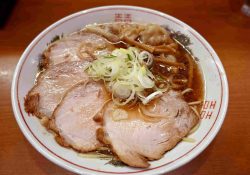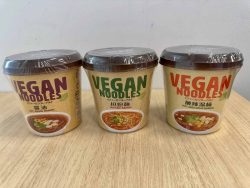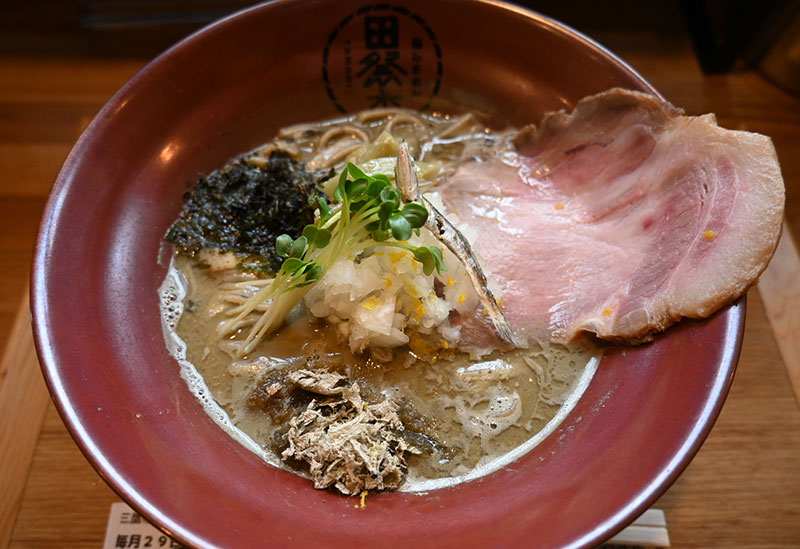
One of the shop’s signature dishes, uobishio ramen (¥900)
11:00 JST, December 9, 2022
“I want to make the ramen that I really want to make, the ramen that I want my customers to eat,” says Mitsuru Tanaka, 48, owner of Koji Ramen Tamaki, located in front of Mitakadai Station on the Keio Inokashira Line in Mitaka City, Tokyo. He overcame two major challenges, a slip-and-fall accident while climbing a mountain and a business crisis caused by the coronavirus pandemic, and managed to renovate the ramen shop he had been running, starting a new shop specializing in ramen with fermented ingredients in October last year. The shop’s ramen, which incorporates a variety of handmade fermented ingredients such as kaeshi sauces that take at least three months to make, will leave your stomach feeling revitalized.
-
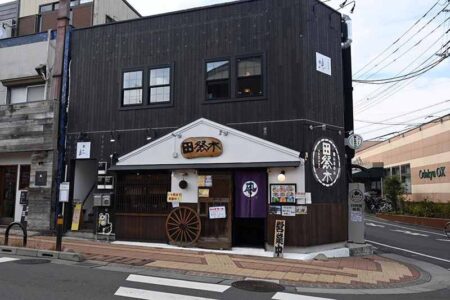
The exterior of the shop
-
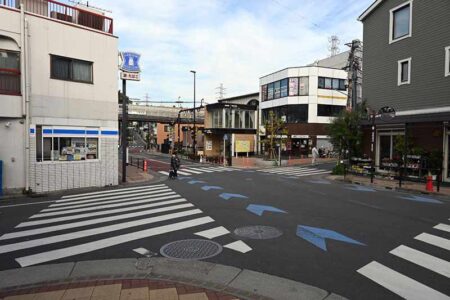
The intersection in front of the shop. The shop faces Mitakadai Station.
-
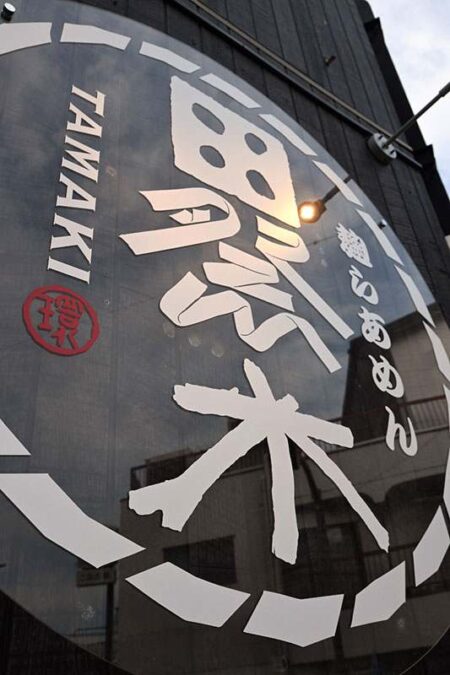
Tamaki’s signboard
The black-walled shop is located on the corner of an intersection just outside the south exit of Mitakadai Station. On a previous visit here, I was so impressed by the straightforward passion for ramen I found that I asked Tanaka for an interview. Four types of ramen occupy the screen of the ticket machine at the entrance. They are uobishio (fish sauce), kokubishio (grain sauce), tsukemen (dipping noodles), and Tenri ramen, which originated in Nara Prefecture, Tanaka’s home prefecture. “Uobishio is more like the sea, while kokubishio is more like the mountains,” says Takeshi Abe, 42, the manager of the shop. From these two recommended ramen dishes, I bought a ticket for uobishio (¥900). This ramen features a homemade ishiru (fermented fish sauce) used for the kaeshi sauce, which is mixed with the ramen broth. To make the sauce, hirako-niboshi (dried fish), clams, kelp, dried bonito flakes and other ingredients are soaked in rice malt and fermented for at least six months, with the mixture being stirred repeatedly.
-

A table and counter seats at the shop
-
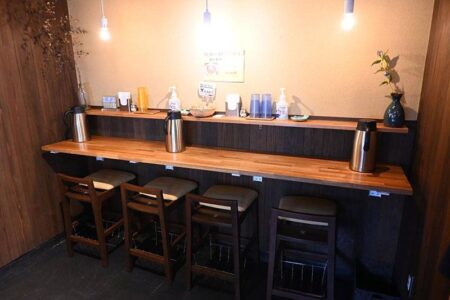
Another row of counter seats
-
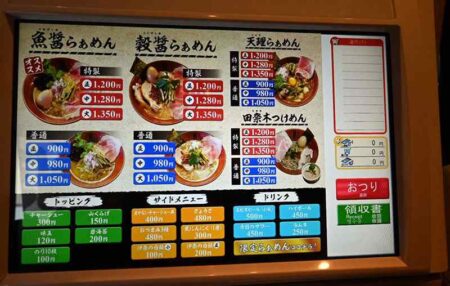
The touchscreen for the shop’s ticket machine
-
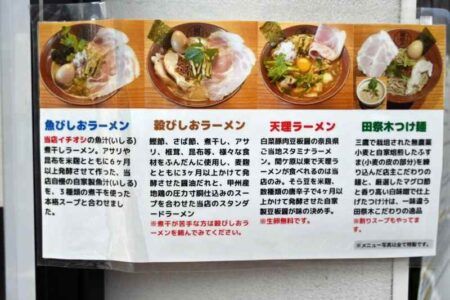
Explanations of the four types of ramen
-

A description of the shop’s fermented ingredients
“Fermentation causes mutations. At some point, the ingredients becomes something else,” Tanaka explains in his own unique way. “After about three months, they start to become silky and smooth, and you get the feeling that ‘oh, something monstrous has been created.’” This ishiru is then combined with a seafood soup. The soup is made by soaking several kinds of dried fish in water overnight, crushing the fish into small pieces, and then squeezing the liquid out of them. Although this process uses more dried fish than boiling, and takes more time, the taste is superior.
-
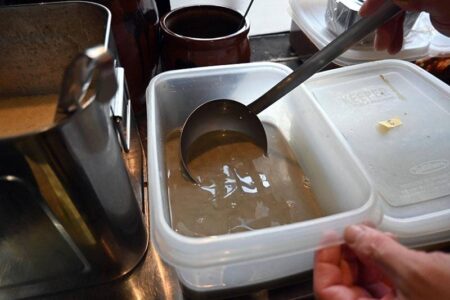
Ishiru fish sauce that has been fermented over six months
-
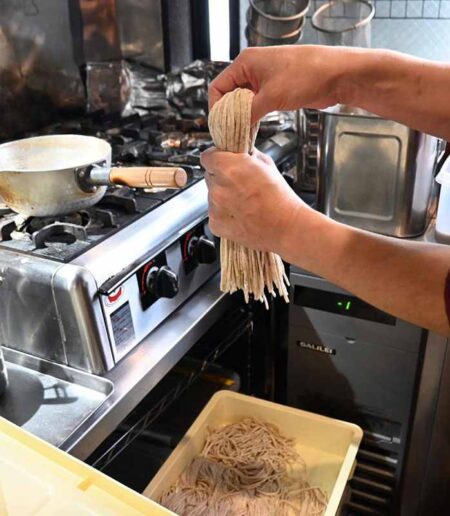
The noodles are kneaded a little before they are boiled.
-
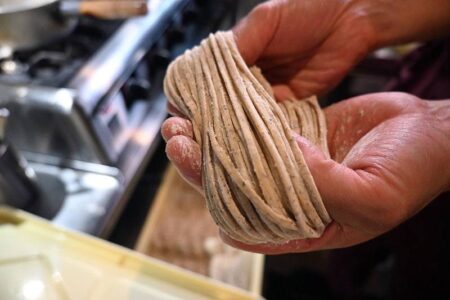
Homemade noodles made with bran
-
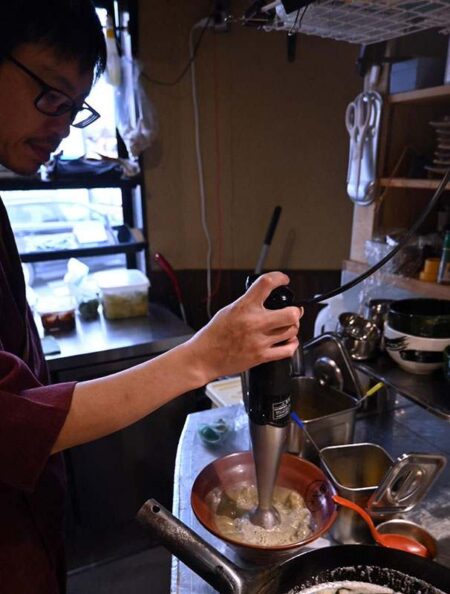
Ishiru fish sauce and a seafood broth are mixed together with a hand blender.
-
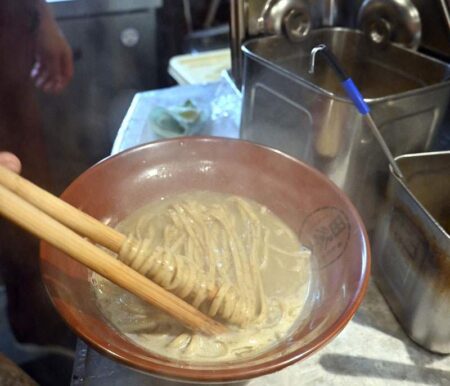
The noodles are arranged in a bowl.
-
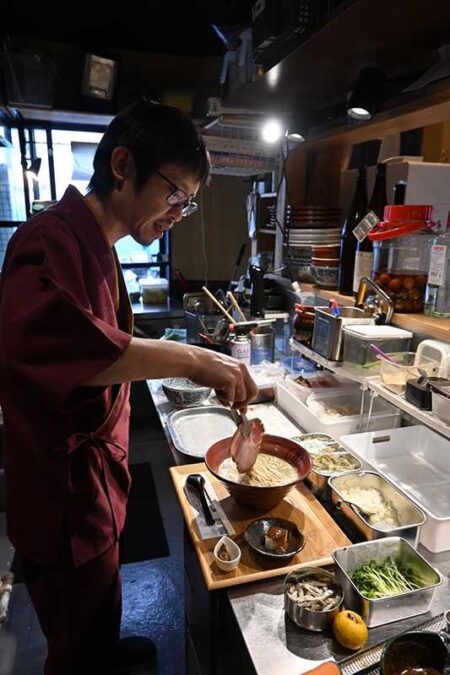
Abe adds the toppings to the ramen.
Abe put the finishing touches on the ramen he was preparing for me and placed it on the table. The soup had a unique greenish tinge. It was topped with several ingredients not usually found with ramen. The soup was very mild and tasty, oozing with umami from the ishiru’s fermentation process. The aroma of yuzu filled my nostrils, and perhaps because the soup is brewed cold, there was no fishy smell.
-
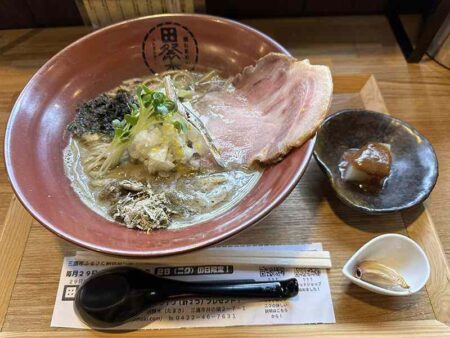
Ramen is served with a small dish of the day and homemade black garlic.
-
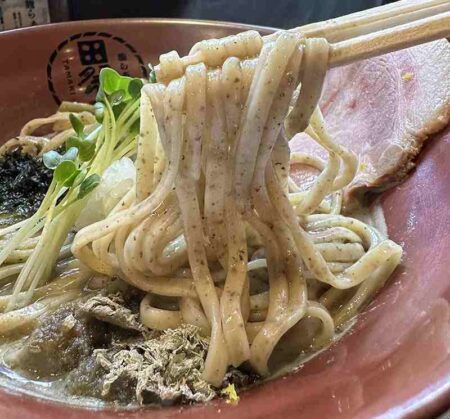
The shop’s noodles are elastic and exude an aroma of wheat.
The homemade noodles have a unique elastic texture and exude a rich wheat aroma. The black grains inside the noodles are from bran, the outer skin of wheat produced in Mitaka, which is roasted and kneaded into the noodles and is said to be rich in dietary fiber and vitamins. The noodles, made daily by a noodle-making machine and left to rest overnight before they are served, are light brown in color because whole wheat flour is mixed into the domestic and Mitaka-grown wheat flours that are used.
The homemade chashu pork toppings for the ramen are soaked in soy sauce malt for about 10 days to soften them, a process accomplished by the malt’s enzymes, and then cooked at a low temperature of 63 degrees. Other toppings include chopped onion, yamakurage (Japanese stem lettuce) pickled in salted malt, hirako dried fish, tororo kelp shavings, iwanori (wild seaweed), kaiware daikon (white radish sprouts), and shaved yuzu peel. In summer, they use sudachi or kabosu citrus fruits instead of yuzu. Bowls of ramen are served on trays, usually with a small side dish and homemade black garlic. The dish of the day was furofuki daikon, and the black garlic had a delicious sweet and sour flavor.
-
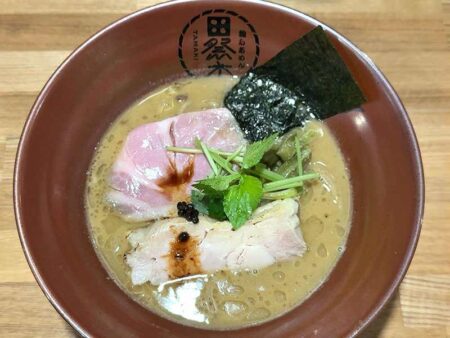
Kokubishio ramen (¥900). Chicken chashu soaked in Japanese sake is also placed on the top.
-

A side dish of furofuki daikon
-
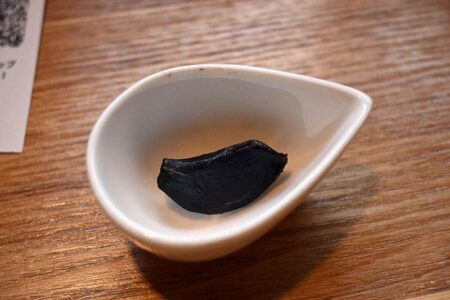
Sweet and sour homemade black garlic
-
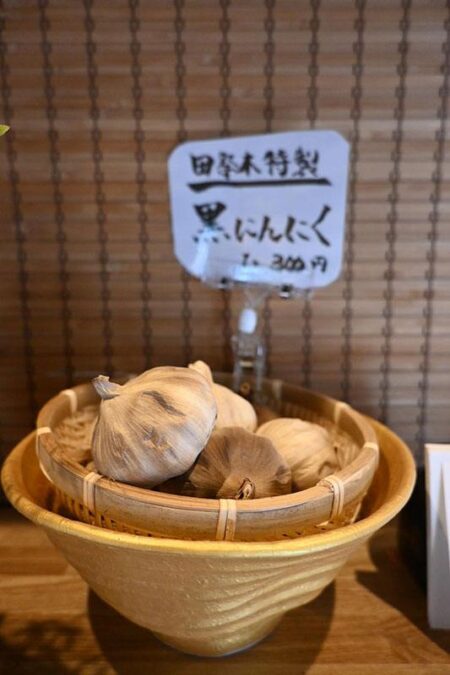
Black garlic sold in the shop
The kokubishio ramen also stands out for its fermented kaeshi sauce, which like the dish itself is called “kokubishio.” For this sauce, more than a dozen ingredients, including clams, dried fish, mackerel, kelp and shiitake mushrooms, are all soaked in soy sauce and fermented for at least three months with barley malt without no boiling ever taking place. When making ramen at the shop, it is combined with chicken broth made from Kenmidori, a brand of chicken from Yamanashi Prefecture.
-
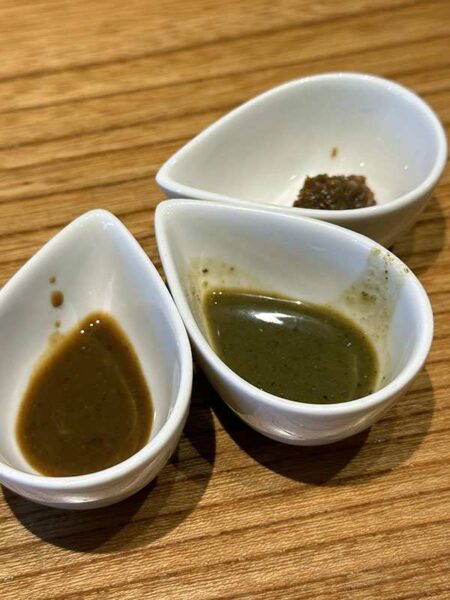
From left to right: Kokubishio, ishiru and homemade chili bean sauce
-
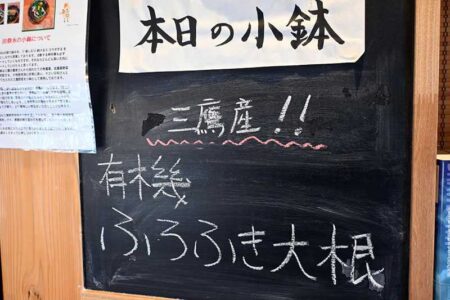
A blackboard in the shop lists the day’s small plates.
-
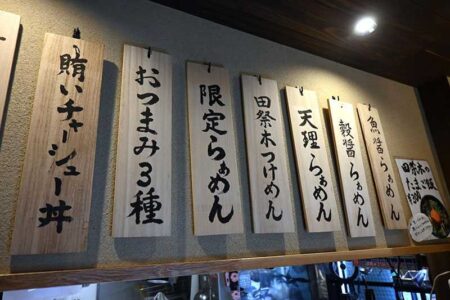
The names of menu items displayed on a wall inside the shop
-
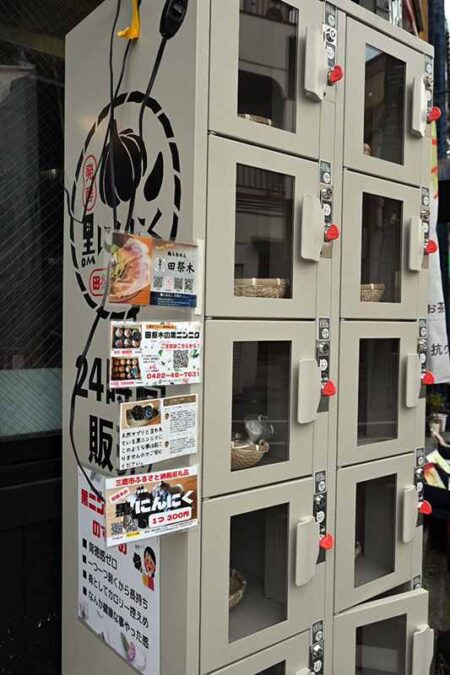
Black garlic is also sold in a vending machine outside the shop.
“Here they are,” said Abe, placing three small bowls of ishiru, kokubishio and homemade chili bean-paste sauce on the table. Tasting each in turn, I found the ishiru to be mild, the kokubishio to be punchy, and the chili bean-paste used for the Tenri ramen to have a rich flavor that was quite different from the store-bought version. Tanaka also took me to the fermentation room, the heart of the shop. Within, plastic containers with date stickers sat lined up on shelves, and batches of ishiru and kokubishio waited for their turn to be served.
-
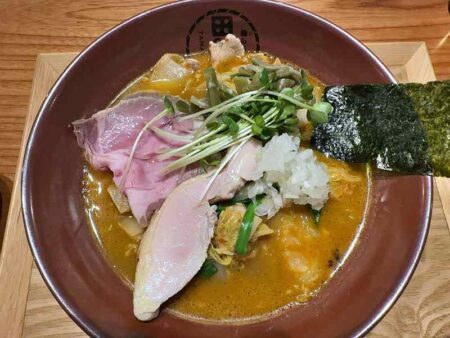
Special Tenri ramen with homemade chili bean paste sauce (¥1,200)
-
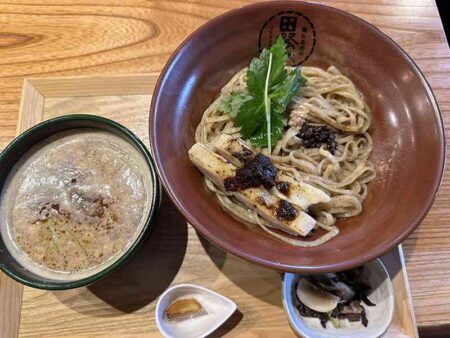
The shop’s tsukemen dipping noodles (¥900) are also delicious.
-

Homemade chili bean sauce used for Tenri ramen
-
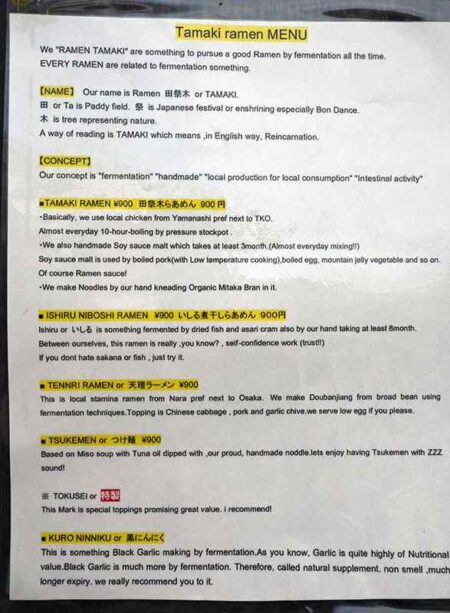
English information posted on the storefront
On my first visit to the shop, I had tsukemen dipping noodles while this time I had the uobishio ramen, and in both cases, I felt my stomach and intestines start to become more active a short time after my meal. I felt as if I had eaten some powerful natto (fermented soybeans) or yogurt, and got the sense that I was physically improved. This is truly “gut-healthy” ramen. Japan has a culture of fermenting many different kinds of foods, and I think this ramen is something to be shown with pride to the rest of the world.
“Bon Odori and fermentation are the same”
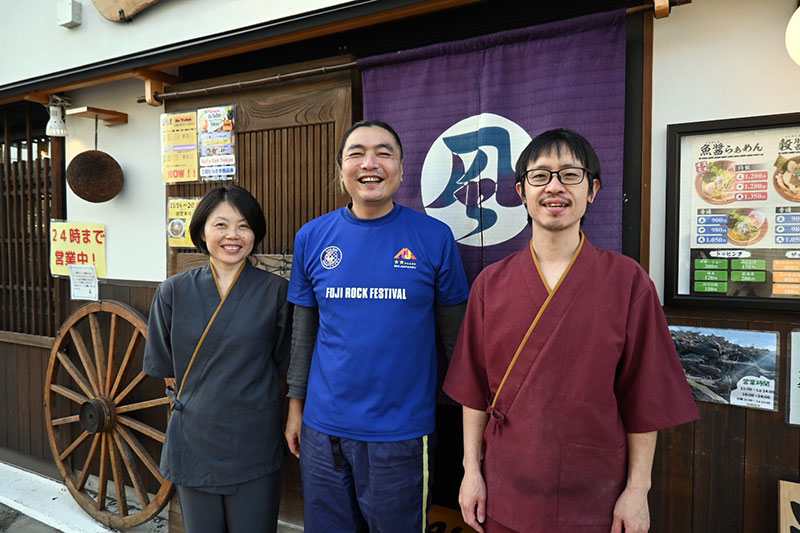
“I love Bon Odori [the Bon festival dance]. I have danced all over Japan and was involved in activities to revitalize local towns through Bon Odori,” Tanaka began his explanation of how he came to make ramen using fermented ingredients. From our first meeting, I got the feeling he was a unique individual. He is gentle-mannered, and soft-spoken. He has an air of someone out of touch with the greater public, the sort of vibe only someone who pursues what he loves and tries to enjoy life to the fullest can achieve.
“At Bon Odori, a unique atmosphere is created by everyone dancing in a circle with the same movements,” Tanaka said, before adding, “I love it so much. Everything melts and fuses together. Suddenly, I realized that this is the same as fermentation.”
This thought occurred to him about five years ago. He had always been interested in fermented foods, and had made his own yogurt, amazake (sweet sake) and natto. At the time, he was running a ramen shop called Honwaka, a predecessor to the Tamaki ramen shop, which was located near the current Tamaki location and was where he began serving limited-edition ramen with fermented ingredients every month. In this way, he began to be able to discern when fermenting ingredients were at their best.
In 2020, however, the coronavirus pandemic took hold, and customers stopped coming. Then, in April, he slipped and fell on Mt. Ryokami, one of Japan’s 100 most famous mountains, in Okuchichibu, Saitama Prefecture. He was rescued and taken to the hospital, but suffered serious injuries to his limbs and was hospitalized for surgery. He had to live on crutches for a while. He almost thought that he would never be able to run the shop again, but during his recuperation, he took time to reflect and came to the conclusion, “From now on, I will make ramen that I want people to eat, not ramen that sells well.” He closed the Honwaka ramen shop in July last year and opened Tamaki in October. The word “tamaki” is Japanese for “circulation,” and the shop’s name, too, is meant to convey this meaning, though the Chinese characters for the shop name differ from that for circulation. “I want to make everything circulate. I have come to think that it is my mission to circulate things and pass them on to future generations,” Tanaka said.
“I want to make everything circulate.”
-
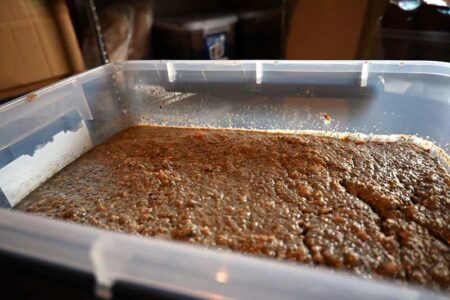
Kokubishio undergoing fermentation
-
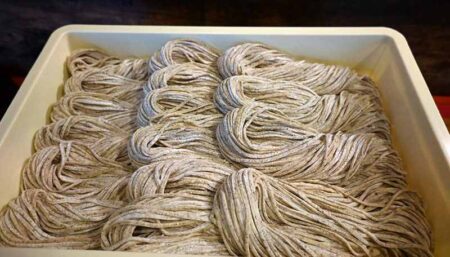
Freshly made homemade noodles
-
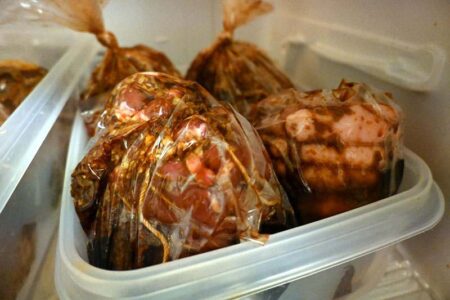
Chashu pork being marinated in soy sauce malt
-
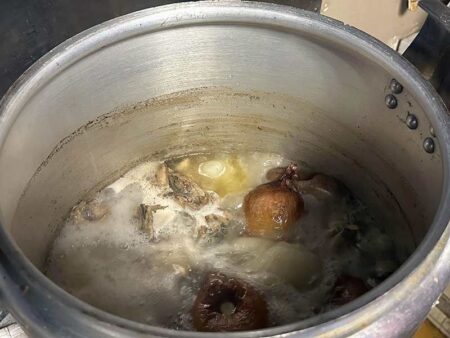
Chicken soup is cooked in a large pot.
In his youth, Tanaka lived the backpacker life from his home base in Thailand, and then when he turned 30, he decided that it was time for him to finally stop “playing around,” so he went to Chiang Mai, northern Thailand, to learn how to make khao soi, a Thai noodle dish. After returning to Japan, he opened a small ramen shop in 2005 that also served khao soi. Three years later, he opened a Thai restaurant. Then, another three years later, by good luck, he was able to move to his current location in front of the station and opened Honwaka.
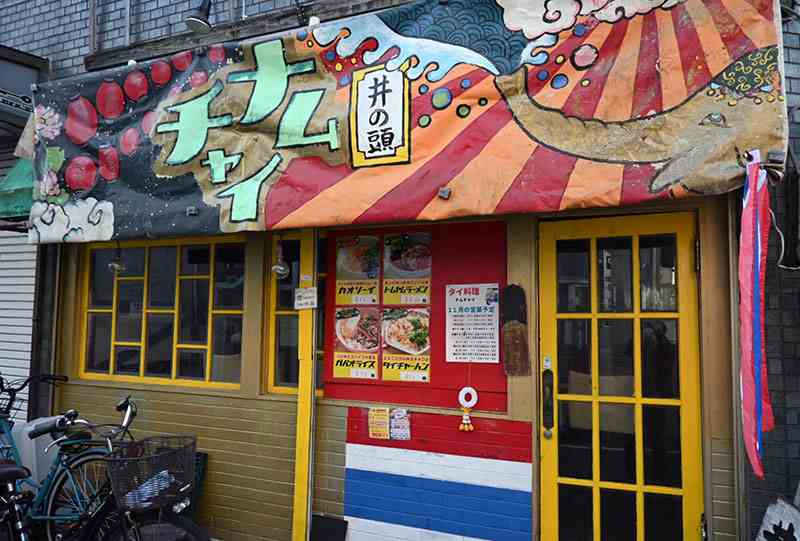
Most recently, he has taken an interest in bamboo. He says that there are many ways to utilize abandoned bamboo groves in different areas, and that they have the potential to help realize a sustainable society. “If you cut down bamboo, make bamboo chips and spread the chips around, those chips will ferment, and the bamboo shoots will grow faster,” he said. “In the spring, when the young bamboo shoots have grown to about 2 meters in height, you can harvest them and make homemade menma for ramen.” Bamboo used at events can also be turned into bamboo charcoal. Fermented bamboo chips can be used to make feed for cattle and pigs, and with the yen’s depreciation driving up the price of feed, Tanaka wonders if domestically produced bamboo feed might be a cheap alternative. To learn more about bamboo, he has visited the Menma Summit held on Awaji Island, Hyogo Prefecture, and the Bamboo Lantern Festival in Usuki City, Oita Prefecture.
Tanaka finds ways to use and recycle things others might think useless, and links them to the future. This is not limited to ramen. He is now working on a big dream, letting it slowly, steadily ferment.

Koji Ramen Tamaki
2-7-1 Inokashira, Mitaka City, Tokyo. Lunchtime is 11:00 a.m. to 2:00 p.m. Until 3:00 p.m. on Sunday. Dinner is 6:00 p.m. to midnight. Closed on Sunday nights.
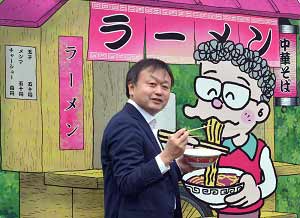
Futoshi Mori, Japan News Senior Writer
Food is a passion. It’s a serious battle for both the cook and the diner. There are many ramen restaurants in Japan that have a tremendous passion for ramen and I’d like to introduce to you some of these passionate establishments, making the best of my experience of enjoying cuisine from both Japan and around the world.
Japanese version
【ラーメンは芸術だ!】発酵系という新分野、三鷹台の「麹らぁめん田祭木」…二つの危機乗り越えた店主

"JN Specialities" POPULAR ARTICLE
-

The Japan News / Weekly Edition (12/12-12/18)
-

Noodle Dining Shunsai / Rich Oyster Ramen to Savor at Odasaga; Experienced 68-year-old Owner Creates Numerous Ramen Varieties
-

The Japan News / Weekly Edition (12/5-12/11)
-

People Keep Loved Ones’ Ashes Close in Special Jewelry, Small Urns as Unique Way to Memorialize Them
-

The Japan News / Weekly Edition (12/19-12/25)
JN ACCESS RANKING
-

Tokyo Economic Security Forum to Hold Inaugural Meeting Amid Tense Global Environment
-

Keidanren Chairman Yoshinobu Tsutsui Visits Kashiwazaki-Kariwa Nuclear Power Plant; Inspects New Emergency Safety System
-

Imports of Rare Earths from China Facing Delays, May Be Caused by Deterioration of Japan-China Relations
-

University of Tokyo Professor Discusses Japanese Economic Security in Interview Ahead of Forum
-

Japan Pulls out of Vietnam Nuclear Project, Complicating Hanoi’s Power Plans



